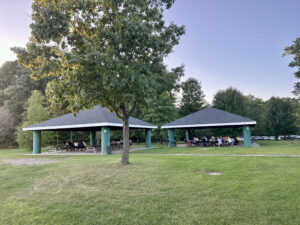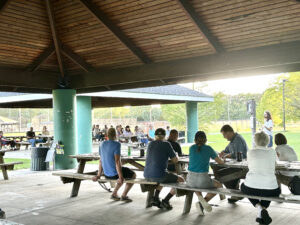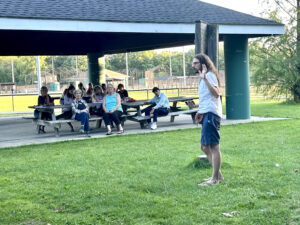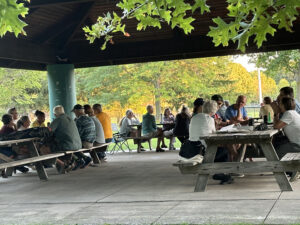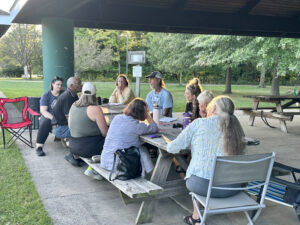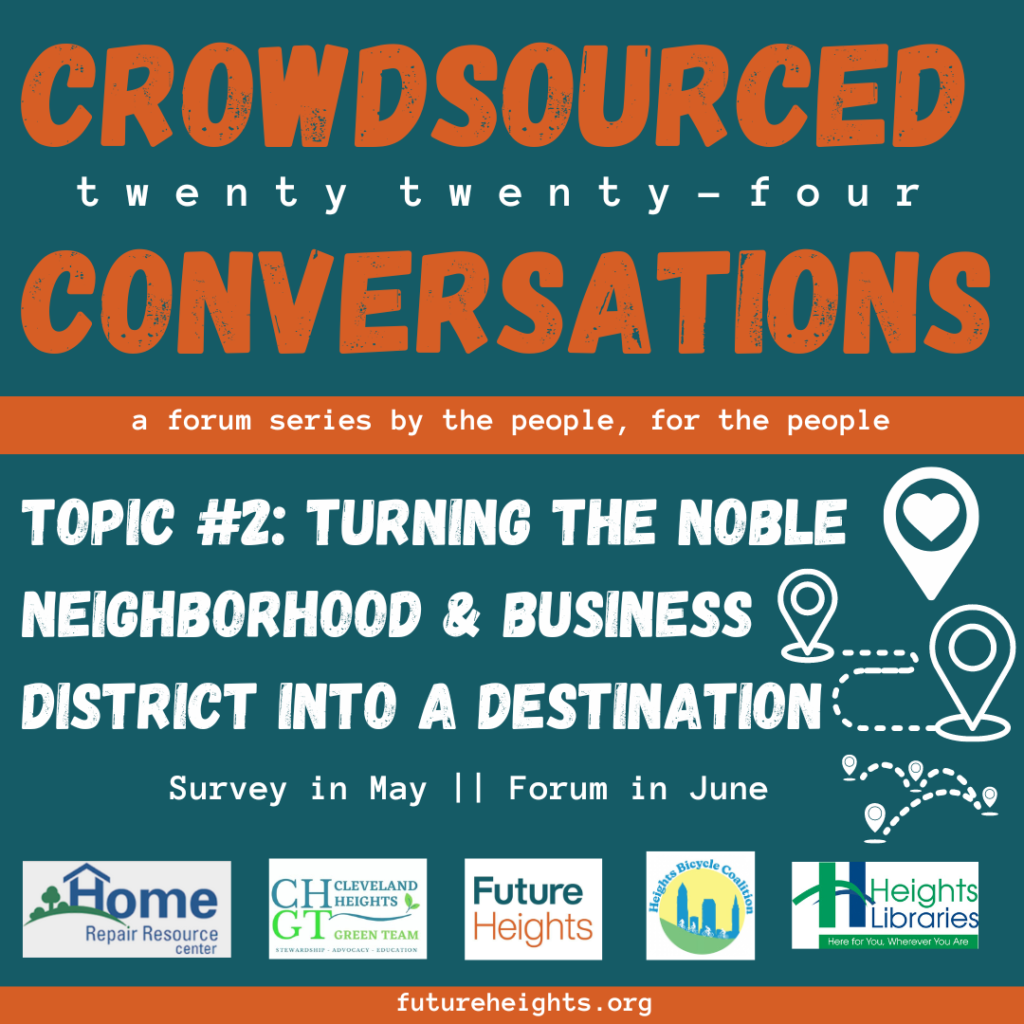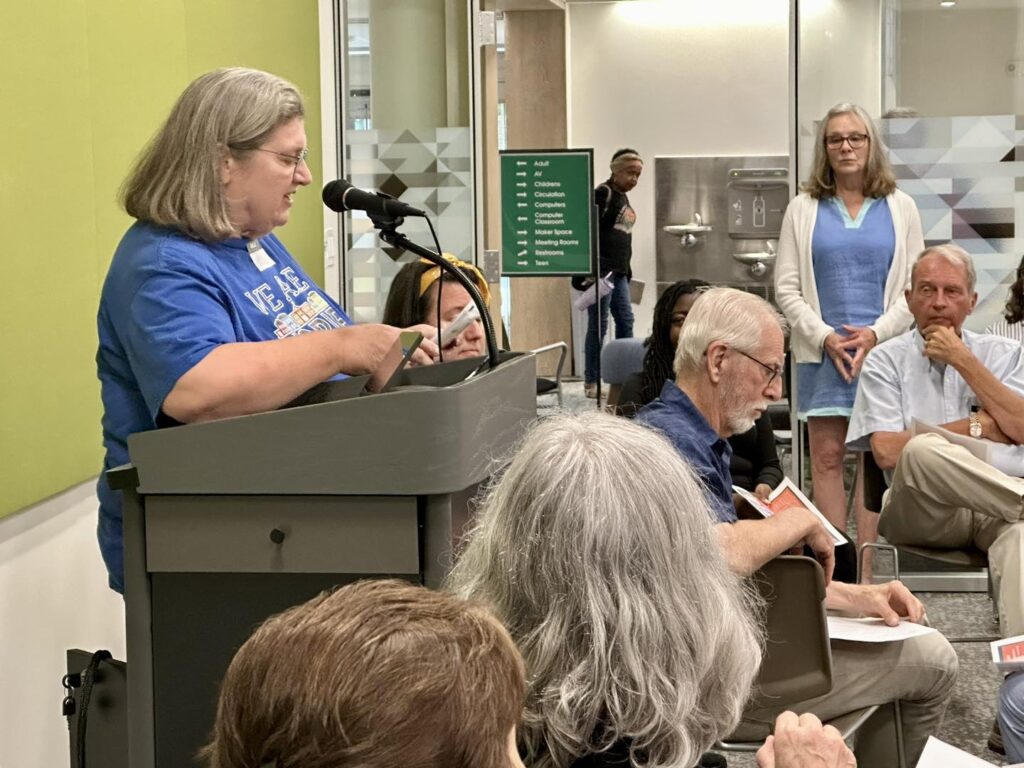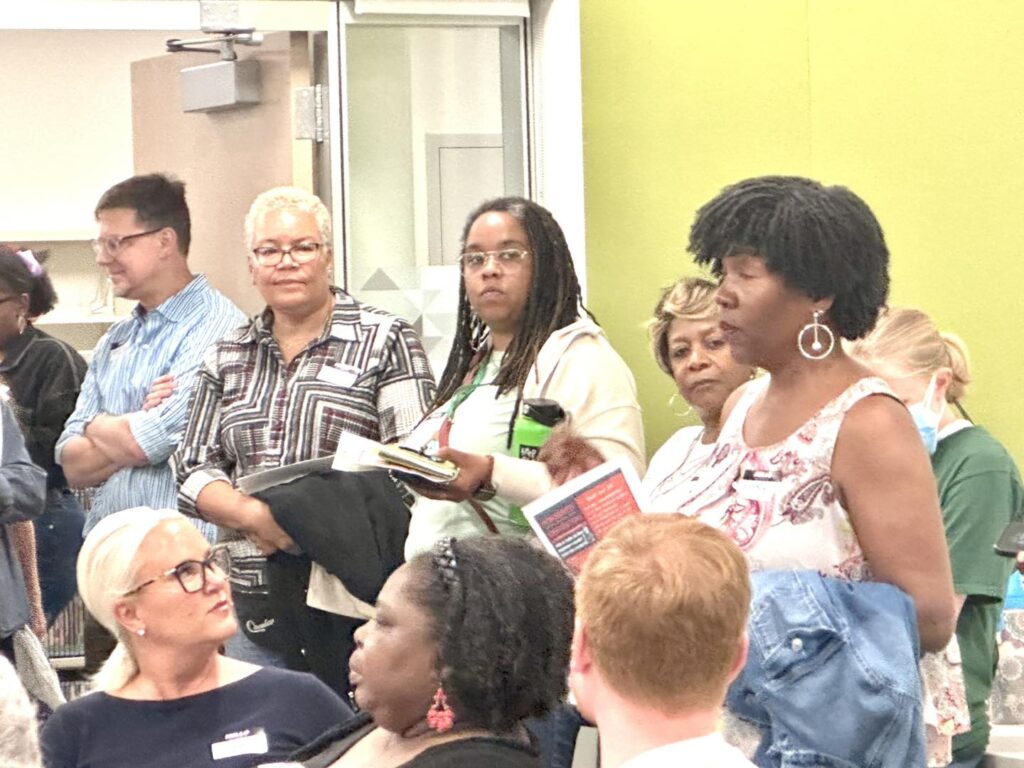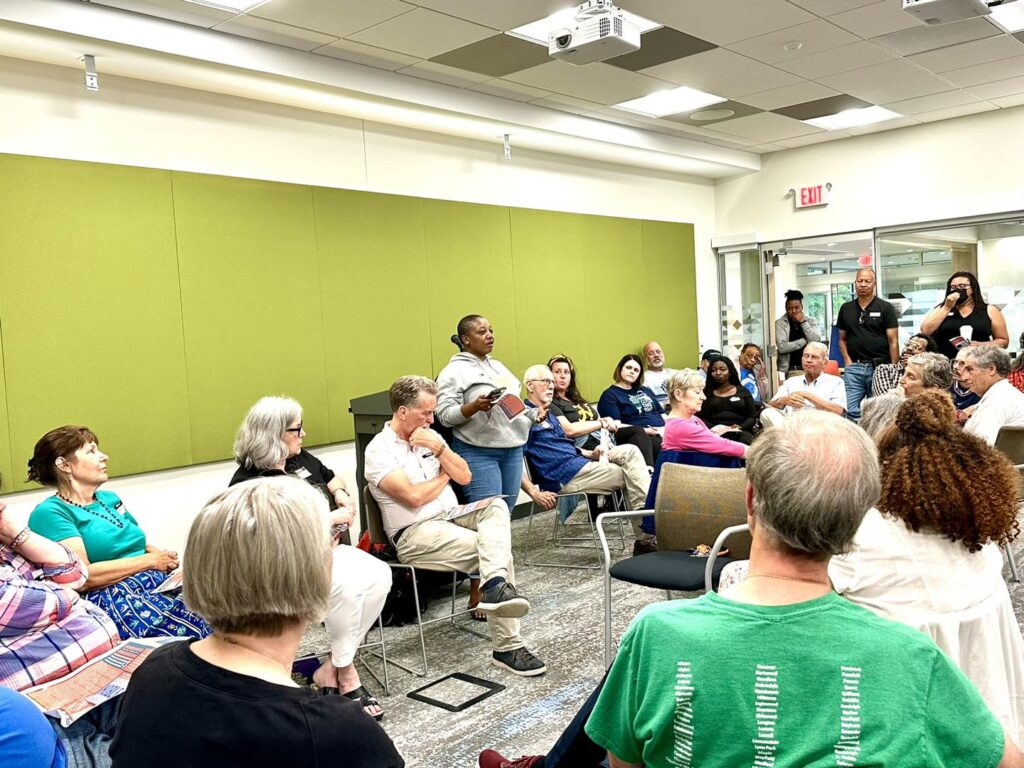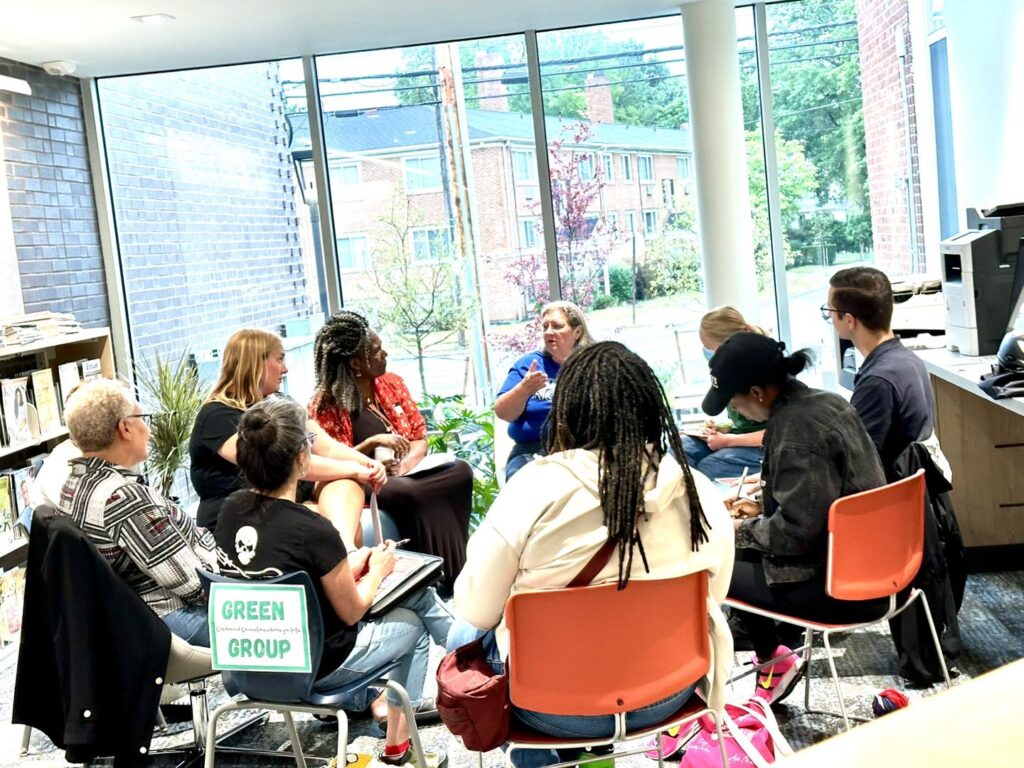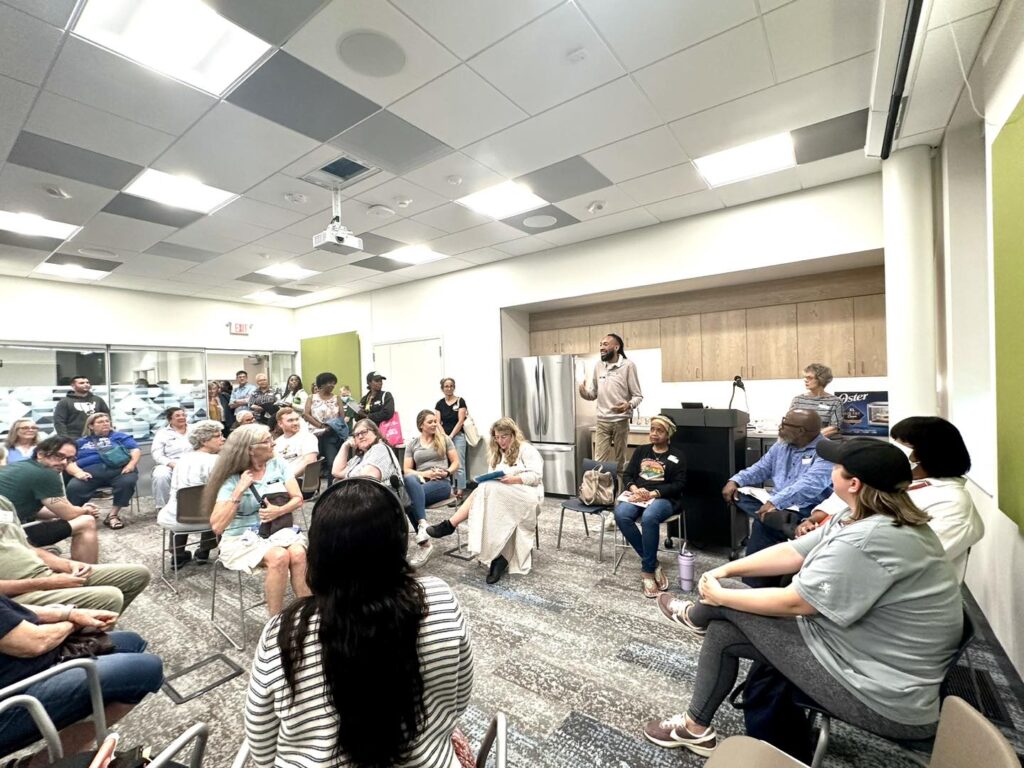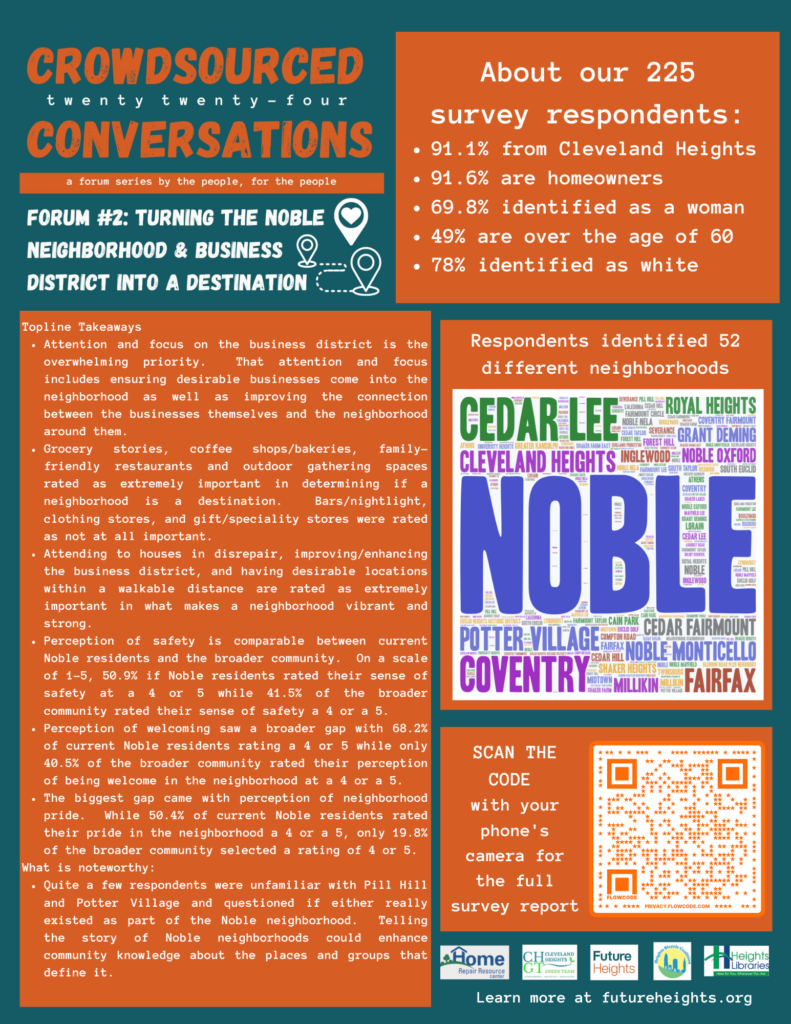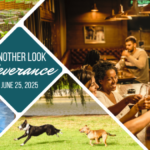University Heights Crowdsourced Conversations – 2024 Topic: Sustainability in University Heights
 On Tuesday, November 19, about 28 University Heights community members gathered in the Large Music Room at Wiley Middle School for the first-ever University Heights Crowdsourced Conversations. Thanks to Mayor Michael Brennan and Deanna Bremer Fisher for their opening remarks.
On Tuesday, November 19, about 28 University Heights community members gathered in the Large Music Room at Wiley Middle School for the first-ever University Heights Crowdsourced Conversations. Thanks to Mayor Michael Brennan and Deanna Bremer Fisher for their opening remarks.
ACTION STEPS: Each group identified meaningful action steps they could take, either individually or as part of the collective. Here are some highlights from each group.
BLUE GROUP: “Sustainability At Home” means shifting attitudes to create new habits, recognizing the power of individual action, and reducing perceptions that sustainable practices are complicated and time-consuming. Ideas include (but are not limited to) recycling, using rain barrels, reducing single-use plastic, replacing lawns and ivy with native pollinators, clover, and meadow plants, sharing 1 car, biking to work, participating in volunteer groups to maintain public spaces (e.g. Friends of the Walt), and establishing a neighborhood tool-sharing library. The city can support progress in sustainability practices city through policy creation, including the upcoming climate action plan or revising zoning codes. Working together on sustainability can lead to increased reasons for social engagement, too — why not make the process fun??
GREEN GROUP: Eating vegetarian or vegan even once a week can be more sustainable and healthful. Rely on biking, walking, and public transportation rather than car ownership. Collect rainwater in barrels for use when watering plants. Check out rebates with the Inflation Reduction Act. Additionally, Rewiring America has resources available for tax credits and rebates on energy-efficient appliances and upgrades. The city could support the process by encouraging/increasing awareness about composting, implementing pedestrian and/or cyclist safety workshops, and increasing awareness around the annual Sustainable Homes award.
PINK GROUP: Education around composting wanted. One group member shared a technique called “lasagna gardening,” or a practice of layering green and brown yard waste in raised gardens to create compost. Another group member shared the benefits of adding solar power for their home, including being less reliant on the primary power grid (i.e. during power outages). Adding more community gardens is of strong interest as is introducing a farmers’ market to University Heights.
PURPLE GROUP: Sometimes the individual changes we make may feel too small — but every environmentally-friendly change made leads to larger systems change. Attitude changes and policy changes can influence each other. For instance, if there’s a community push to make the city more pedestrian/cyclist-friendly, then that opens the door to rethinking how the city would need to be designed in order to reduce resident need to rely on a car for local transportation. Change is always possible when the community comes together to use their voice.
Here are some additional ideas for action steps:
- Host your own small group action-oriented discussions with your family, friends, and neighbors. You can even use our Small Group Discussion Questions – UH CC – Sustainability in University Heights to get you started!
- Write articles or op-eds — or maybe even inquire about being a columnist — for the Heights Observer.
- Join us for the next Crowdsourced Conversation forum to meet other engaged Heights residents.
- Sustainability in University Heights
Resources
City of University Heights
- “Opt-In” to recycle in UH
- If you have questions about the recycling program, please contact Allen Pennington at apennington@universityheights.com.
- University Heights Greenhouse Gas Inventory info here.
- Electric Vehicle Charger Guide here.
- Solar Panel Guide for Homeowners here.
- Apply to join the Citizens Advisory Committee on Sustainability here.
- If you have questions about the committee, please contact Deanna Bremer Fisher at dbfisher@universityheights.com.
- Learn more about the City of University Heights’ Climate Action Plan and other sustainability efforts here.
Rust Belt Riders
- Composting service — learn more here.
Friends of The Walt
Heights Bicycle Coalition
- Learn more here.
Heights Tree People
- Learn more here.
Cleveland Heights Green Team
- Learn more here.
Power a Clean Future Ohio
- Tax credits for sustainability-related household upgrades – learn more here.
Solar Options
Rewiring America
- Learn more here.
Lasagna Gardening
Read the complete survey data report for “Sustainability in University Heights” here.
Crowdsourced Conversations – 2024 Topic #4: Severance Town Center
On Tuesday, November 12, about 111 Heights community members gathered in the cafeteria at Heights High School for our fourth Crowdsourced Conversations form of 2024. Thanks to Ryan Porter from MPact Collective for his informational opening remarks — all of us are excited to see what progress can be made on this important site in the heart of Cleveland Heights.
ACTION STEPS: Each group identified meaningful action steps they could take, either individually or as part of the collective. Here are some highlights from each group.
BLUE GROUP: Writing articles about the redevelopment process would increase transparency for the community and keep residents informed. Having an easy-to-use website with updated materials would be beneficial for much the same reason. Advocating for land use that will build density and keep/bring residents to Cleveland Heights is the key.
GREEN GROUP: Prioritizing unique businesses/organizations that could bring people to Severance would be great — thinking about what the community does not yet have is critical. Examples include an indoor sports facility, a “cat café,” co-working spaces, etc. Emphasizing car-lite infrastructure to make it easy for the space to be both walkable and bikeable could make it feel like a true space for community connections. Having simple ways for the community to remain informed about the process is essential, too. Ideas include a YouTube channel, website, social media, and recording meetings/presentations so those who could not be in attendance can review the information later. This transparency may help distrust turn into trust.
GREY GROUP: Severance currently feels like a “dead zone” so the focus should be on bringing it to life. Make it walkable and bikeable, including consideration of how busy Mayfield Road is — and how challenging it is to cross the road as a pedestrian. There needs to be an intentional push to bring younger people to the table to get their insights and learn what would keep them in Cleveland Heights long-term. Engaging with a diverse representation of the community — including renters — is key to large development projects. That is the best way to understand what kind of development will have a lasting impact that will help the community grow.
LILAC GROUP: This process cannot forget the people who are already living and working in Severance. Their input and vision for the future is critical. Skepticism often accompanies anything that hinges on financial gain — there is a sense of distrust around the process because there is a sense that money will win out over community input. Explore out-of-the-box options like urban farming or an entertainment center with bowling, go-karts, etc. that speak to what’s not currently available in the community while also being true to the spirit of Cleveland Heights. Communication is critical, especially when it comes to trust-building and creating a sustainable engagement process. Make it easy for residents to know what’s happening, step by step. Perhaps the process could be turned into a documentary or a photography project — maybe students could be engaged to carry this out.
MAROON GROUP: The community has many questions about Namdar, the owner of the bulk of the property that comprises Severance Town Center. Some of those questions include: How do we hold Namdar accountable?; What are the tax write-offs that Namdar is benefiting from under its current arrangement?; Why is Namdar not selling?; Is Namdar paying its taxes?; What legal position are residents in to pursue collective action against Namdar?; What kind of leverage does Cleveland Heights have against Namdar?; Have other communities sued Namdar?; Has Namdar been benefiting from depreciation?; Has Namdar turned down people who want to rent space at Severance?; Why did they shut down the Marshalls?; Who owns what in Severance? Increased transparency around questions like these would be a benefit as this redevelopment process continues. MPact Collective establishing a website that includes information such as its timeline, project stages, and PowerPoints would increase trust. Ultimately, a redeveloped Severance should be inclusive to all members of the community.
ORANGE GROUP: Establish incubator spaces for emerging small business or light manufacturing. Circulator bus needed to bring residents from across the city to Severance and help folks be better connected across the city as a whole. Maybe Severance could become an RTA hub that would create easy access between Cleveland Heights and Downtown Cleveland. Keep the youth of the community in mind throughout the redevelopment process. Perhaps cohousing could be explored — this intergenerational housing model ties apartment buildings with shared community space.
PINK GROUP: Identify other communities who have gone through a similar process and speak with those involved. There could be great benefit in learning from what others have done. Additionally, it could be valuable to explore why some residents have chosen to leave Cleveland Heights as a means of understanding what could keep current residents here and bring in new residents, too. Partnering with other key developments currently going on — such as Park Synagogue — could benefit the process. Finding some “easy/small wins” could boost overall confidence in the process. Ideas include: fixing the ring road, experimenting with pop-up arts or vendors, and bringing food trucks to the space. Things like this could build excitement and draw positive focus to Severance as this process moves along.
PURPLE GROUP: Information about the redevelopment process should be in one central location (ideally a website) that includes updated plans, photos and renderings, and offer a space for residents to pose questions. In addition to the website, a quarterly townhall-style gathering could allow for a “live” version of the website. Including residents in any planning processes ongoing with the City and MPact or other developers ensures the community is being represented. Make Severance a fun place to be — include an “adult playground” with pickleball courts, climbing walls, etc. or an outdoor music/performance space. Businesses like Rust Belt Riders (composting service) or Repeat Glass (glass-specific recycling service) could be great additions. Making the space mixed-use is a “future-proofing” tactic that will allow Severance to continue its evolution as the community itself evolves, too.
RED GROUP: More greenspace, less parking! Perhaps a transit hub connecting Severance and University Circle. Keep younger people in Cleveland Heights — engage and involve them in determining what matters to them when choosing a place to live. Make Severance feel like a destination. Keep focus on environmentally sustainable processes and options. Wanted: a transparent process where timelines and other aspects of the plan are shared regularly with the community. Mostly, residents would like to feel hopeful about the redevelopment — “little wins” and signs of progress are key to that hope-building.
TURQUOISE GROUP: Generally speaking, more data is needed to understand the best use of Severance. Market analysis plus community feedback would lead to an informed determination. Services like daycare, doggy-daycare, veterinary care, etc. might be a good direction to go in so there isn’t a strong reliance on retail businesses. Perhaps a “business zone” or science park would be a good fit. So would “fun” apartment-style housing for seniors or those who simply don’t want to have to take care of a lawn. Greenspace is always wanted but ensuring it can be cared for must be factored into the planning.
YELLOW GROUP: Severance redevelopment creates an opportunity to connect the North and South parts of Cleveland Heights with a hub in the middle. Focus should be on youth and creating safe spaces for them to gather. Engaging students as part of the process increases sense of belonging and is future-thinking. The overall design should keep the aesthetics and vibe of Cleveland Heights in mind. Use social media and pop-up events to engage the entire community in the planning process, similar to what was done with Van Aken.
Here are some additional ideas for action steps:
- Host your own small group action-oriented discussions with your family, friends, and neighbors. You can even use our Small Group Discussion Questions – CC’24 – Severance Town Center to get you started!
- Write articles or op-eds — or maybe even inquire about being a columnist — for the Heights Observer.
- Join us for the next Crowdsourced Conversation forum to meet other engaged Heights residents.
- Severance Town Center Forum
Resources
City of Cleveland Heights
MPact Collective
Namdar Realty Group
Severance Action Group (SAG)
- Resident-led initiative
- Website
Cohousing
- Learn more here.
If you have a suggestion for an additional resource to be added, please email info@futureheights.org.
Read the Complete Survey Report – CC’24 Severance Town Center here.
 For the first time ever, the City of University Heights is hosting its very own Crowdsourced Conversations! The topic: Sustainability. Crowdsourced Conversations is a community-building program that provides a safe and welcoming space for Heights residents to come together and brainstorm ways to become more engaged in the community.
For the first time ever, the City of University Heights is hosting its very own Crowdsourced Conversations! The topic: Sustainability. Crowdsourced Conversations is a community-building program that provides a safe and welcoming space for Heights residents to come together and brainstorm ways to become more engaged in the community.
The survey was live from October 1-October 31st. The forum took place on Tuesday, November 19 from 7pm-8:30pm in the Large Music Room, (M109) at Wiley Middle School. Opening remarks were made by Mayor Michael Brennan along with Deanna Bremer Fisher before we turned it over to our small group discussions.
This event was free to attend.
How Crowdsourced Conversations flows:
Step One: The Survey!
- The purpose of our survey is to reach as many Heights stakeholders as possible in order to generate meaningful action-oriented small group discussion questions for our event on the topic.
Step Two: The Data!
- Once the survey closes, we will generate a report to share the results. This report will be housed on the FutureHeights website and will be shared with community partners, elected officials, and more.
- We will also use the survey results to generate small group discussion questions for our Crowdsourced Conversations event on the topic.
Step Three: The Conversation!
- All Heights residents/stakeholders are encouraged to participate in our Crowdsourced Conversations forum.
- While there will be brief opening remarks by guest speakers, this forum series emphasizes the small group discussions that are action-oriented and strengths-based.
Step Four: The Follow-up!
- After our forum night, all event participants will have the opportunity to stay connected to the other members of their small group discussion and will receive electronic copies of the survey report and any other resources utilized during the event.
- All event participants will also be able to help us co-create a Resource Page on the forum topic that will live on the FutureHeights website.
This forum series will be an opportunity to connect with other Heights residents about topics that impact us in a variety of overlapping ways. We hope you can join us for all four conversations! Any questions, connect with info@futureheights.org.
THANK YOU!
This topic was selected by the City of University Heights Citizens Advisory Committee on Sustainability.
This forum is being planned in partnership with FutureHeights and the City of University Heights as well as the UH residents. Thank you for the joy, wisdom, and enthusiasm you bring to the table!
Crowdsourced Conversations – 2024 Topic #3: Our Public Parks
On Thursday, August 29, around 40 Heights community members gathered at Forest Hill Park for our third Crowdsourced Conversations form of 2024. Thanks to Eric Yarham (Friends of Cain Park, Gather Well Cleveland Heights) for his insightful opening remarks!
ACTION STEPS: Each group identified meaningful action steps they could take, either individually or as part of the collective. Here are some highlights from each group.
BLUE/PINK GROUP: This group would like to see more wayfinding in our parks that help people learn more about the trails and the features they are encountering. Additionally, signage about the plant-life could be educational. Signage could make residents feel more comfortable in the parks and could possibly lead to greater overall usage.
GREEN GROUP: This group would like to advocate for the return of police on bicycles as this could help support residents feeling safe in the parks and also allow police officers more opportunities to interact with residents. Additionally, making wayfinding a project for community members to help improve signage and even mapping (perhaps drone mapping!) allows for residents to feel more comfortable in the parks. Thinking about our parks as year-round assets is also critical. Winter walks/activities help keep parks vibrant even in colder months.
ORANGE GROUP: This group would love to see a more comprehensive depiction of the parks and what they have to offer on the city’s website. Emphasis on both trees and native plantings would be appreciated and are also areas where residents can get involved. That said, volunteer burnout is a real thing, so establishing supports for volunteers would help make the work sustainable.
PURPLE GROUP: This group would love to see community-driven “Friends of [Each Park]” groups who work directly with the City’s Parks & Rec departments to keep an open dialogue between residents and the city while also being able to support each other in efforts to amplify our parks as a resource and an asset for the community. Groups (grassroots/neighborhood or larger entities, like the libraries or our schools) could use the parks to host events/gatherings as a way to bring more people and perhaps introduce them to these spaces.
RED GROUP: This group thought using a resource like the Heights Observer could be beneficial. Through citizen journalism, individuals or groups could focus on one park at a time and talk about the attributes and assets of each. Residents can also use their voices to express their thoughts regarding our parks by making public comments at City Council meetings or connecting with city or elected officials to share their ideas.
Here are some additional ideas for action steps:
- Host your own small group action-oriented discussions with your family, friends, and neighbors. You can even use our small group discussion questions from our “Our Public Parks” forum to get you started!
- Write articles or op-eds — or maybe even inquire about being a columnist — for the Heights Observer.
- Join us for the next Crowdsourced Conversation forum to meet other engaged Heights residents.
- Our Public Parks Forum
Resources
City of Cleveland Heights
- Parks and Recreation webpage
- Cumberland Pool webpage
- Women Out Walking webpage
- Special Events webpage
- Outdoor Facilities webpage
- Parks webpage
- Picnic Shelter Info webpage
- In most cases, you must be a resident of Cleveland Heights to reserve a picnic shelter (some exceptions, including parks shared with East Cleveland) and you must go in person to the Cleveland Heights Community Center to make your reservation. The cost is $25 with a refundable $50 security deposit. To learn more about making a reservation, please call the rec center at 216-691-7373.
- Parks with picnic shelters:
- Barbara H. Boyd Park (one single shelter)
- Cumberland Park (one single shelter)
- Denison Park (one single shelter)
- Forest Hill Park
- Forest Hill 1 (one single shelter)
- Forest Hill 2A & 2B (one double shelter)
City of University Heights
- Parks & Recreation webpage
- Purvis Park
- Beryl E. Rothschild Municipal Pool
- Walter Stinson Community Park
- Silsby Road Pocket Park
- Ashurst Rain Garden
Grassroots/community groups
- Friends of Heights Parks (Facebook group)
- Friends of Cain Park (Facebook group)
- Friends of Forest Hill Park (Facebook group)
- Friends of Lower Lake
- Heights Tree People
- Cleveland Heights Green Team
Gather Well Cleveland Heights
- Check out this Cleveland Heights-based podcast for episodes about how community members are gathering.
Survey Data Report
Access the Complete Survey Report – CC’24 Our Public Parks
Crowdsourced Conversations – 2024 Topic #2: Turning the Noble Neighborhood & Business District into a Destination
On Wednesday, June 26, over 60 Heights community members gathered at the newly renovated Noble Library for our second Crowdsourced Conversations form of 2024. Thanks to Noble Library Branch Manager Constance Dickerson and Brenda May (Noble Neighbors) for their inspiring opening remarks!
ACTION STEPS: Each group identified meaningful action steps they could take, either individually or as part of the collective. Here are some highlights from each group.
BLUE GROUP: This group emphasized that Noble residents should walk, bike and make their presence known in the community while also forging new relationships with our neighbors and members of the community. The best way to demonstrate how many assets your neighborhood has is to show folks around. This group is organizing a neighborhood walk through on July 31st at 5:30pm. Meet at the Noble Library!
GREEN GROUP: This group wants to: advocate for a city position dedicated to attracting small and large businesses. Define developer-friendly parameters such as zoning regulations. Explore city ownership of retail spaces (e.g., CVS building). Host more destination events. Examples include live music and food truck parks to attract the 20-50-year-old demographic. Develop a “Noble Story” walk to instill local history and pride among residents. Feature “We are Noble” stories in the Heights Observer to increase community exposure. Create more vibrant art and spaces. Encourage more neighbor-to-neighbor interaction to strengthen community bonds.
ORANGE GROUP: Broadcast new ideas with neighbors, neighborhood groups, city staff, and elected officials. Establish a Farmer’s Market. Bring in programs like the Heights Music Hop. Go to Council meetings and encourage Get Out the Vote. Do a City wide “festival”. Noble could be the area with Food trucks and music. Encourage an ice cream shop. Convert the old CVS at Monticello and Noble into a restaurant.
PINK GROUP: There is value in defining the anchors of the neighborhood: Mayfield/ Noble; Monticello/ Noble; Caledonia. Effort should be made to connect each part of the neighborhood. Part of that has to do with attracting desirable businesses that are walkable/bikeable for residents. Additionally community clean-up days enhance neighborhood pride. Get folks of all ages involved! Consider creating handmade signs that read “Please don’t litter here, we love our neighborhood” to reduce litter.
PURPLE GROUP: This group advocates for a creation of a think-tank/mentorship model to collaborate and partner with the City, business owners, realtors both to support existing businesses and attract perspective businesses. Those perspective new business owners should be part of a conversation with residents and the city to discuss the needs of the neighborhood. Other support for businesses include help navigating the city and its code violations, assistance clarifying and understanding commercial leases and getting issues resolved with landlords. This approach could allow Noble to be a model for how to attract new business and the types of businesses that would be beneficial to the community.
RED GROUP: Get out and tell the story of your experience in the neighborhood! This group believes there’s a need to show more neighborhood pride and promote the neighborhood to combat the negative perception that Noble has. Emphasis on “talking the neighborhood up and not down” when speaking to outsiders is a must. It is imperative to change the narrative.
Here are some additional ideas for action steps:
- Host your own small group action-oriented discussions with your family, friends, and neighbors. You can even use our small group discussion questions from our “Turning the Noble Neighborhood & Business District Into a Destination” forum to get you started!
- Write articles or op-eds — or maybe even inquire about being a columnist — for the Heights Observer.
- Join us for the next Crowdsourced Conversation forum to meet other engaged Heights residents.
- Turning Noble Into a Destination Forum
RESOURCES
City of Cleveland Heights
Noble Neighborhood Resources:
- Noble Library Branch
- Home Repair Resource Center
- Start Right CDC
- Noble Neighbors
- Green Noble (Facebook Group)
- Potter Village (Facebook Group)
- Montford Community Garden
- Oxford Community Garden
- Delmore Orchard
Strategies for supporting neighborhood businesses:
- Utilize them!
- Get to know the people who work in your neighborhood’s businesses. Introduce yourself!
- Talk about them with your neighbors
- Use platforms like Yelp, Google, and social media to offer positive shout outs about your favorite neighborhood spots — a good rating goes a long way!
- Follow neighborhood small businesses on social media. Like, comment on, save, and share their posts as often as you can — this helps their posts reach a broader audience.
If you have suggestions for additional resources to be added to this page, please email info@futureheights.org
Survey Data Report
Complete Survey Report – CC’24 Turning the Noble Neighborhood & Business District Into a Destination
Crowdsourced Conversations – 2024 Topic #1: Active Transportation: Living Less Car-Centric in the Heights
On Tuesday, April 30, over 50 Heights community members gathered at Made Cleveland in Coventry Village for our first Crowdsourced Conversations form of 2024!
ACTION STEPS: Each group identified meaningful action steps they could take, either individually or as part of the collective. Here are some highlights from each group.
BLUE GROUP: Choosing to live less car-centric requires some planning: bunch errands together, for instance, or think about what can be accomplished in proximity — being intentional about routes can make it simpler to walk or bike instead of driving to local destinations. This group wants to commit to using their cars for a minimum of one fewer local trips/errands on a weekly basis. Having improved biking infrastructure (including access to bike racks) would make this infinitely easier.
GREEN GROUP: Public transit could be a great option for those wishing to rely less on cars, but the routes are sometimes too far apart or not convenient to get to desired destinations. There are also many in our community who either have never used public transit before or have very limited experience. With greater exposure to taking the bus/rapid places, more people may opt to use public transit. Working with the community to understand their public transit needs could make it much easier to set down car keys when traveling locally.
ORANGE GROUP: Safety and accessibility are keys to transportation, regardless of the mode. Having quality sidewalks, protected & connected bike lanes as well as safe places to lock bikes once destinations are reached, and making public transit easy to use are all ways to reduce reliance on cars. Creating community-building opportunities around walking/biking/taking public transit to an event or a location could help those who might ordinarily just drive somewhere be more likely to want to use a car-free mode of transit instead.
PINK GROUP: Infrastructure improvements could include adding more trees/shrubs to the medians and having more brick roads, as both have proven to reduce speeding. Clearing debris, snow/ice, and other obstructions from bike lanes and pedestrian pathways would make walking or cycling places safer and more effortless. Creating intentional spaces for pedestrians — places where cars are not permitted — increases a sense of safety and encourages community to gather while possibly also supporting local businesses.
PURPLE GROUP: Education is the key. The more people know how to use public transit, the more aware of cyclist/pedestrian traffic laws, the more confident they become to utilize these methods of travel. The current mindset is car-first, but if a better balance could be achieved, not only would travel be safer for everyone, it would normalize and promote non-driving modes of transit.
RED GROUP: Incentivizing non-car options could help motivate residents to opt to walk/bike/take public transit more often. For instance, a tax credit for the purchase of an e-bike. Making public more accessible would make it easier to use as well. Perhaps a “hub” could be established where a number of different routes could be accessed. Committing to a “car free” day once per week (especially during warmer months) could create less car-centric habits.
Here are some additional ideas for action steps:
- Host your own small group action-oriented discussions with your family, friends, and neighbors. You can even use our small group discussion questions from our “Active Transportation: Living Less Car-Centric in the Heights” forum to get you started!
- Write articles or op-eds — or maybe even inquire about being a columnist — for the Heights Observer.
- Join us for the next Crowdsourced Conversation forum to meet other engaged Heights residents.
- Charlie Mosbrook’s opening remarks
- James Liou’s opening remarks
- Lively discussion
- Small group
- Active Transportation Forum
- Lots of folks biked to the forum
Resources
- Safe Streets for Cleveland Heights (learn more/sign up for updates here)
- Visit this interactive map to help identify target areas for the Safe Streets initiative
- Learn more about the Complete Streets plan
- Transportation assistance:
- City of Cleveland Heights Office on Aging – Van Transportation to errands & medical appointments
- To sign up – contact Carolyn Neal at cneal@clevelandheights.gov or 216-691-7342
- Already signed up – contact Anne Griffith at agriffith@clevelandheights.gov or 216-691-7194 to change or cancel a ride.
- Senior Transportation Connection: STC will take you to medical appointments, senior centers, grocery shopping and more! Senior Transportation Connection provides coordinated, efficient, affordable transportation for seniors and adults with disabilities throughout Cuyahoga County.
- City of Cleveland Heights Office on Aging – Van Transportation to errands & medical appointments
Rapid Transit Authority (RTA)
- RTA website
- RTA Call Customer service regarding requests and/or service ideas at 216-621-9500.
- Attend a virtual Board meetings (more info here)
Useful Transit/Transportation Apps
- Google Maps – you can get driving, walking, public transit, and cycling-specific directions
- Transit – this app gives real-time updates about when buses and other forms of public transit are arriving as well as directions
- EZ Fare – this app allows you to pay for your RTA transit fare in advance and pay for your ride once you get on the bus (etc.)
- TransLōc – use this app to track CircleLink shuttle buses
- CircleLink shuttle general info here.
- Uber – rideshare app
- Lyft – rideshare app
- Lime – locate and use electric scooters
- Bike Cleveland: Bike Cleveland is Greater Cleveland’s bike advocacy and education organization. Become a member to support their mission of creating a region that is sustainable, connected, healthy, and vibrant by promoting bicycling and advocating for safe and equitable transportation for all. Sign up for Bike Cleveland’s signature ride, the Fundo (distances vary: 10 to 60 miles). Proceeds benefit Bike Cleveland.
- Heights Bicycle Coalition: HBC is a chapter of Bike Cleveland. Their footprint includes Cleveland Heights, Shaker Heights, University, and South Euclid. They host recurring bike rides on Tuesday evenings, every other week. Rides are 8-10 miles at a casual, family-friendly pace. The meetup location for each ride is different each time, so join the email list and/or follow their Facebook Group for updates. The Heights Bicycle Coalition Facebook Group is also a great space to connect with members to ask questions, find a ride buddy, share ideas, etc. HBC has committees for Advocacy, Education & Outreach, and Marketing & Communications. They are always looking for volunteers to help out when your schedule allows.
- Slow Roll Cleveland: An evening social ride every Monday, May through October (see full schedule here). Rides are 8-10 miles at a casual, social pace. An inclusive, community bike ride with about 200-800 riders touching a different Cleveland neighborhood every week. Rides are supported by a squad of volunteers.
- League of American Bicyclists (Bike League): national advocacy organization that empowers people through education to be safer and feel more comfortable and confident to bike more by offering resources and certifications.
- Cedar Lee Bikes – local bike repair & service shop – 2309 Lee Road or call 216-471-8160
- Cain Park Bicycle – local bike repair & service shop – 1904 Lee Road or call (216) 320-0209
- Other great area bike shops – Century Cycles (Shaker Heights) and Joy Machines (Ohio City). Stop by for a test ride on a bike or ebike.
- Ohio City Bicycle Co-Op – OCBC sells used bikes, helps people fix bikes, and more!
Cycling safety & resources:
- Get Ready to Ride with the ABC Quick Check – a helpful video showing an easy way to make sure your bike is in good working order before hitting the road. Learn the steps (air-brakes-chain) and some additional tips to consider when riding an electric assist or bike (also known as an ebike).
- Ride Smart Videos. Here are a series of videos on a range of bike safety topics from the Bike League.
- ebikes – I’ll defer to Cole on this one!
- Google Maps has a bike mode where you can map out directions to a destination you want to bike to. The directions guide you through less busy streets and streets with bike lanes or bike boulevards.
- Rack & Roll with Greater Cleveland RTA – how to bring your bike on our bus and rail system
- Bikes Direct – buy bikes at a reasonable rate
- Active Transit Toolkit (ioby)
Books:
- Streetfight: Handbook for an Urban Revolution by Janette Sadik-Khan
- The Walkable City by Jeff Speck
- Confessions of a Recovering Engineer by Charles Marohn
Videos:
- Not Just Bikes – YouTube Channel
- The Walkable City TEDTalk – Jeff Speck
Other resources:
- A Guide to Measuring Complete Streets Progress
- DriveOhio: DriveOhio is an initiative of the Ohio Department of Transportation, serving as the state’s hub for smart mobility technology on the ground and in the air.
- CircuitNR: A model for us to look at: “Since 2019, the City of New Rochelle has partnered up with Circuit to provide a 100% electric micro-transit solution for residents and visitors. For zero cost, Circuit takes riders anywhere within the coverage area zone through our on-demand app or by waving down a driver.”
If you have a suggestion for an additional resource, send it to info@futureheights.org.
Survey Data Report
Complete Survey Report – CC’24 Active Transportation_ Living Less Car-Centric in the Heights.
Crowdsourced Conversations – 2023 Topic #4: Planning & Development in The Heights
On Thursday, November 2, over 60 Heights community members gathered at the Lee Road Library to participate in our fourth and final Crowdsourced Conversations event of 2023, this one on the topic of “Planning and Development in the Heights.” Special thanks to Eric Zamft, City of Cleveland Heights Director of Planning and Development, for his opening remarks!
ACTION STEPS: Each group identified meaningful action steps they could take, either individually or as part of the collective. Here are some highlights from each group.
BLUE GROUP: There is a strong desire for better communication between the residents and the city so that residents both know what’s going on in their neighborhoods and the nearby business districts but also how they can get involved in productive ways. They suggested having Street or Neighborhood Captains (or take turns by rotating through anyone who might be willing to volunteer) who attended city meetings and reported back to the group so they could make informed determinations about action steps they could take as neighbors.
GREEN GROUP: Just like the Blue Group, the Green Group wishes for greater communication from the city about upcoming or ongoing projects but also acknowledges the two-way street where residents should be more proactive in staying informed. They also emphasized the importance of working together with area groups, neighbors, or others in the community who care about the same issues in order to make progress. More can be accomplished together than flying solo.
ORANGE GROUP: Heights residents should think of themselves as ambassadors in their neighbors, both in terms of making newcomers feel welcome and bring neighbors together, encouraging folks to get involved and stay involved with what’s happening both on their streets and in the city-at-large. They also see a benefit in engaging neighbors who live near a proposed development site and would like to see more intentional outreach to those residents prior to a project being approved or implemented. Additionally, thinking about our business districts as destinations that include more than going into one shop or restaurant and leaving and instead create a cohesive atmosphere where shoppers and diners are encouraged to linger, stopping into multiple businesses or having an inviting outdoor spot to meet up.
PINK GROUP: Many neighborhood groups got started because of a unifying community issue — it takes work to sustain those groups over time, so finding as many reasons to gather and work together helps keep the connections strong. There are also many community-wide groups to join, if there isn’t an active block club available. Racism is also a significant issue to confront, especially when thinking about development in the Northern part of the city. Pledging to stay aware, to show up at public meetings, and to speak up about issues of community importance is crucial to building the best possible version of the city.
PURPLE GROUP: Gaining greater understanding for how our business districts operate is important when thinking about how best to support current retailers/restauranteers and how to think about growing or improve the districts. This group noted (as did others) that much of the discussion tied back to how the Heights “used to be” — while that reminiscing has its benefits, there is even more benefit to thinking about what made the old times feel like “glory days” and what elements might be missing in our present day business districts or neighborhoods. Community attention and efforts should focus on what is actionable or doable now or in the near future.
RED GROUP: Make projects small and manageable. Small successes will breed more success, potentially resulting in substantial change. Attempting to tackle many-faceted issues can lead to feelings of defeat and burnout. Using available resources like the Heights Observer to share news/gain news helps keep community members on the same page. Getting to know neighbors and see what is important to those who live close by can help build coalitions and build unity around shared interests. Finding ways to engage youth or younger members of the community is an ongoing goal.
YELLOW GROUP: Think outside the box when it comes to spreading the word about various community topics. While some may only be reachable via social media/digital platforms, others don’t use that type of media at all. Being creative about how to spread the word and thinking about how your neighbors prefer to communicate can help ensure everyone stays informed. Similarly, creative ways to attract and support new small businesses are needed to build the districts back up. Creating incubator spaces for entrepreneurs to get started before moving into their own brick-and-mortar, establishing mentorship opportunities that link small business owners who are able to offer pointers and other support to up-and-coming small business owners, and making space for dialogue that includes what goods and services residents are hoping for, what small businesses are interested in moving into a district, and how the city is able to support the process would make commercial districts feel more intentional and community-focused.
Here are some additional ideas for action steps:
- Host your own small group action-oriented discussions with your family, friends, and neighbors. You can even use our small group discussion questions from our “Planning & Development in the Heights” event to get you started!
- Write articles or op-eds — or maybe even inquire about being a columnist — for the Heights Observer.
- Join us for the next Crowdsourced Conversation forum to meet other engaged Heights residents.
- Eric Zamft opening remarks
- Small group discussion
- Planning & Development Forum
- Small group discussion
- Small group discussion
- Reporting out to the group
Resources:
Our Business Districts:
- Ideas for how to support small businesses:
- Shop/Eat Local Whenever Possible
- Be intentional about trying a restaurant or checking out a shop you’ve maybe never been to before.
- Create a Small Business Bingo to play with your friends & neighbors
- Follow (AND LIKE AND COMMENT AND SHARE) small business social media posts – this may seem like a small thing, but every time you like/comment/share a post, it influences the algorithm which allows for more people to see the post
- Use your own social media platforms to share about your favorite small businesses
- Write reviews on Yelp, Google, Facebook, and other similar platforms – or even write a feature for the Heights Observer
- Small business attract residents to neighborhoods – they matter! Small businesses provide community spaces and are a place to meet with (or run into) neighbors. Be a good ambassador for your neighborhood’s business district and talk up places you frequent with your neighbors
- Get to know the people who work in the stores/restaurants — this is a great way to stay connected to the latest news and really understand how you and your neighbors can show up for small businesses in ways that are meaningful for them, too
- Plan a “Neighborhood Takeover Night” in a business district — have neighbors meet up at a particular dining establishment or shop for your next Block Club meeting or social gathering
- NOTE: If you are expecting more than 10 people, make sure you reach out to the small business to make a reservation so they know you’re coming.
- Holidays are coming: THINK LOCAL, SHOP LOCAL, EAT LOCAL.
- Cedar Fairmount news & information
- Cedar Lee news and information
- Coventry Village news & information
- Taylor Tudor/Cain Park district news & information
Planning and Development – City of Cleveland Heights
- About/general info
- Master Plan (implemented in 2017)
- Economic Development
- Architectural Board of Review info
- Planning Commission
- Transportation & Environmental Sustainability Committee
- Parks and Recreation Advisory Board
- Board of Zoning Appeals
- City Council Committees
- Sign up for the City of Cleveland Heights e-news
Planning and Development – City of University Heights
- Economic Development – support for UH small businesses
- Architectural Board of Review info
- City Planning Commission info
- Board of Zoning Appeals – meeting info
- City of University Heights Mosaic magazine
- City of University Heights weekly e-news
If you have a suggestion for an additional resource, send it to info@futureheights.org.
Our survey results:
Review the complete survey report for CC’23 Planning and Development in the Heights here.
WELCOME TO THE RESOURCE PAGE FOR OUR CROWDSOURCED CONVERSATION FORUM ON THE TOPIC OF BUILDING COMMUNITY WITH RENTERS AND LANDLORDS!
On Wednesday, August 30 around 50 Heights community members gathered at Beth El The Heights Synagogue to participate in our third Crowdsourced Conversations event of 2023, this one on the topic of “Building Community with Renters and Landlords.” Special thanks to Cleveland Heights Councilperson Tony Cuda and Cole Ware (Coventry Neighborhood Group, Coventry Living Room Project) for their opening remarks!
ACTION STEPS: Each group identified meaningful action steps they could take, either individually or as part of the collective. Here are some highlights from each group.
BLUE GROUP: They identified several ways to increase a sense of welcoming and belonging in their neighborhoods. Ideas included adding public transportation; more mixed-use development; community building events such as Crowdsourced Conversations; more street events featuring food trucks; farmers market; block club events; participating in the Heights Bike Coalition; street directory listing neighbors; a street Facebook page; Welcome wagon; and setting a water bowl out for people walking their dogs.
GREEN GROUP: They also identified key factors that can aid in building a welcoming neighborhood. Their ideas include creating opportunities for everyone to contribute/get involved; neighborhood parties; having an active street association; being mindful of who your neighbors are (ex: families that have kids might be interested in different activities than those who don’t have kids); avoiding assumptions and pre-judgements about who your neighbors are; sharing resources, helping out neighbors (ex: lawn maintenance); circulating information about area community gardens or other groups to join.
PINK GROUP: They noted that neighborhoods with established block clubs or groups make it a little easier for residents to get to know each other — so if your neighborhood has such a group, make sure to let new neighbors know about it! They also suggested that if it’s possible to for you to spend time sitting out on your front porch or spend time in your front lawn, that increases a sense of welcoming and helps neighbors get to know each other. Having events like a neighborhood garage sale or hosting annual block parties are also great assets in community-building with neighbors.
PURPLE GROUP: They had some action steps about building a strong connection with the community, including: join your neighborhood school’s PTA (you don’t have to have kids in the school to be active in the PTA); knowing what groups are doing in the community increases a sense of connection and eases the path to participation; signing up for free newsletters offered by schools, neighborhood groups, and others is a good way to stay informed (possible follow-up for the CC organizers is including these on the resources page); attending events (ex: Homecoming parade on September 22); volunteering for one-time activities, such as Reaching Heights’ One and Done program or Noble Neighbors welcome back to school chalking at the schools the evening before classes start. They also suggested bringing homeowners and renters together in informal gatherings like block parties – “it is difficult to demonize someone when you’ve shared hotdogs with them.”
RED GROUP: This group had a few area landlords who also live in the neighborhoods where their rental properties are. They are intentional about building community with their tenants — which is a strong advantage to having landlords who are also local. Members of this group also thought creating/bringing back Welcome Packets to distribute to new residents would help them feel instantly more part of the community and aware of the resources and opportunities available. Doing regular neighborhood cleanups to reduce trash/litter/debris helps build neighborhood pride while also giving residents a chance to get to know each other.
YELLOW GROUP: This group also advocated for the return of Welcome Packets for both new residents and new business owners. Additionally, they would like to see more apartment buildings with common areas included in the design. Perhaps if renters were given more of an opportunity to meet and connect with each other, it could help them build stronger ties with the community-at-large.
Here are some additional ideas for action steps:
- Host your own small group action-oriented discussions with your family, friends, and neighbors. You can even use our small group discussion questions from our “Building Community with Renters and Landlords” event to get you started!
- Write articles or op-eds — or maybe even inquire about being a columnist — for the Heights Observer.
- Join us for the next Crowdsourced Conversation forum to meet other engaged Heights residents.
- Renters & Landlords Forum
Resources:
For renters and landlords:
- Chapter 5321 – Ohio Revised Code Ohio Laws
- The Legal Aid Society of Cleveland: Tenant’s Rights
- Ohio State Bar Association Law Facts: Tenant-Landlord Rights and Obligations
- US Department of Housing & Urban Development (HUD): Tenant Right Laws & Protections – Ohio
- Ohio Attorney General: Fair Housing Guide for Landlords
- Emergency Rental Assistance
- Cleveland Heights Municipal Court Rent Escrow Procedures
- City of Cleveland Heights info about rentals
- Cleveland Heights Municipal Court Rent Escrow Procedures
- Cleveland Heights Municipal Court: Landlord/Tenant information
- City of Cleveland Heights Housing Inspections FAQ’s
- City of Cleveland Heights Rental Inspection information & Checklist
- Cleveland Heights apartments – landlord & property owner contacts
- City of University Heights info for renters & landlords
- City of University Heights rental registration form
- Resources for new residents: Cleveland Heights;
Community-Building:
- City of Cleveland Heights – Block parties
- Learn about City of Cleveland Heights events by signing up for the weekly e-news.
- City of University Heights – Block parties
- Learn about City of University Heights events by signing up for the weekly e-news.
- Heights Library’s “Check Us Out” program guide
- Learn more about Cleveland Heights Neighborhood Groups
If you have suggestions for additional resources to be added to this page, please email info@futureheights.org.
WELCOME TO THE RESOURCE PAGE FOR OUR CROWDSOURCED CONVERSATION FORUM ON THE TOPIC OF TRAVELING AROUND TOWN!
 On Thursday, June 29th around 40 Heights community members gathered at Coventry PEACE to participate in our second Crowdsourced Conversations event of 2023, this one on the topic of “Traveling Around Town.” Special thanks to University Heights Councilperson Brian King and Deidre McPherson (Bike Cleveland, Heights Biking Coalition) for their opening remarks!
On Thursday, June 29th around 40 Heights community members gathered at Coventry PEACE to participate in our second Crowdsourced Conversations event of 2023, this one on the topic of “Traveling Around Town.” Special thanks to University Heights Councilperson Brian King and Deidre McPherson (Bike Cleveland, Heights Biking Coalition) for their opening remarks!
ACTION STEPS: Each group identified meaningful action steps they could take, either individually or as part of the collective. Here are some highlights from each group.
BLUE GROUP: Commit to: (1) using a bicycle instead of a car for trips less than a few miles; (2) walking instead of using a car when the destination is less than a mile; (3) shopping more locally; (4) being better organized to avoid multiple trips requiring the use of a car; (5) carpooling to get to work, socialize, run errands, etc.; (6) using public transportation to go downtown for events instead of driving; (7) being “tougher” when the weather is bad so we walk or bike instead of taking a car. Some suggested advocacy steps: (1) A use tax based upon the mileage driven; (2) An increase in the gas tax; (3) Safer sidewalks and crosswalks; (4) Better public transportation; (5) Better infrastructure for bicycling; (6) Sidewalks and bike lanes cleared of snow in the winter; (7) Advocating for our public officials to spend more money on public transportation and infrastructure for dedicated bike lanes and pass.
GREEN GROUP: Break the habit of reaching for the car keys and see what socializing or errands, etc. can be done by walking/rolling or biking. Seek out walking/rolling/biking groups to gain that social support for being less car-dependent. Share your stories with neighbors about the times you’ve walked/rolled or biked places to provide that example of how it’s possible to be less car-dependent. Advocate for better infrastructure for biking and walking/rolling to make it easier for everyone. Pose the question to your household: do we need a car or do we need two cars? What would our lives look like with one car only or no cars at all? Start the conversation and see where it leads! Consider the health and environmental benefits of walking/rolling/biking as well as the the cost of upkeep on car-focused infrastructure. It might help lower the city’s costs if more people were setting the car keys aside in favor of other methods of getting around town.
ORANGE GROUP: Advocacy to bring circulator buses into the Heights would help connect the neighborhoods and allow residents easy ways to get around town without using a car. There are also free transportation services for seniors and those with disabilities — more information about those services will be linked below in our resource list. Additionally, allowing golf cart-sized vehicles on the road or even designating certain roads to be not-for-cars would increase safety.
PINK GROUP: Look to college campuses as a model for local transportation. How do they make it easier for students not to drive to class? Some of those practices could be implemented if the Heights had a local shuttle bus/circulator. Adding more “last mile” options, like rental bikes or scooters, would help those who might feel like they live just a little too far away get to the train or to their destination without picking up the car keys. Above all, make it “frictionless” to try out less car-dependent modes of transport — in other words, make it easy for residents to get where they need to go without a car. This means thinking pedestrian-centric and cyclist-centric when strategizing about planning & development in our communities.
PURPLE GROUP: Reimagine transportation infrastructure during planning for new development projects. Organize events & other draws that encourage/require walking (walkable restaurant or historic tours, scavenger hunts. Organize “bike rodeos” & other supports for biking in the schools, thus building a culture of biking in the next generation. Implement more biking-related instruction/education so cyclists know the laws and how to keep themselves safe. Advocate for more neighborhood-centric/hyper-hyper-local retail, grocery, restaurants, etc. so residents had what they needed nearby, lessening their impulse to drive elsewhere for goods & services. Add more bike racks and other bike-friendly amenities to make cycling more desirable. Be mindful that some residents choose to walk/roll/bike for fun or exercise while others use non-car methods as their main mode of getting around. For those who rely on pedestrian, cycling, or public transportation options, city planning needs to consider non-car methods of transportation as a requirement, not a recreational frill.
RED GROUP: Talk with officials about bike/walking lanes and trails, and including way-finding for designated lanes & trails. Determine if the Planning Commission or Planning Department can require consideration of alternative modes of transit when developments come before them, or would it require legislation from the council. More projects like the Compton Greenway that include traffic calming elements. Improve promotion and communication of existing programs of free transportations services such as paratransit, Circle Link, and other programs offered by RTA, office of aging and county. Look at what other cities are doing, such as free group sharing on-demand electric vehicles.
YELLOW GROUP: Think about the neighborhood where you live and what is easy to access nearby and what isn’t currently there, causing you to have to drive. Advocate for more biking infrastructure to be included in neighborhoods — things like bike racks, bike locks, bike repair stations in addition to bike lanes. Lobby elected officials/planning to create more live/work areas. Reduce traffic and speeds in areas of large poverty — poorer neighborhoods have more car related deaths since many of the residents do not own a car. Ban trucks (commercial and passenger) from certain streets. Build the time into your day to walk/roll/bike places instead of drive — believe it or not, there are some instances it can take almost the same amount of time to get there without a car (or needing to find parking!) as it takes to drive.
Here are some additional ideas for action steps:
- Host your own small group action-oriented discussions with your family, friends, and neighbors. You can even use our small group discussion questions for our “Traveling Around Town” event to get you started!
- Write articles or op-eds — or maybe even inquire about being a columnist — for the Heights Observer.
- Join us for the next Crowdsourced Conversation forum to meet other engaged Heights residents.
- UH Councilperson Brian King offering opening remarks
- Traveling Around Town Forum
- Deidre McPherson offering opening remarks
- Small group discussion
- Listening to the report out
- CH Councilman Anthony Mattox reporting out
Resources:
- Bike Cleveland: Bike Cleveland is Greater Cleveland’s bike advocacy and education organization. Become a member to support their mission of creating a region that is sustainable, connected, healthy, and vibrant by promoting bicycling and advocating for safe and equitable transportation for all. Sign up for Bike Cleveland’s signature ride, the Fundo (distances vary: 10 to 60 miles). Proceeds benefit Bike Cleveland.
- Heights Bicycle Coalition: HBC is a chapter of Bike Cleveland. Their footprint includes Cleveland Heights, Shaker Heights, University, and South Euclid. They host recurring bike rides on Tuesday evenings, every other week. Rides are 8-10 miles at a casual, family-friendly pace. The meetup location for each ride is different each time, so join the email list and/or follow their Facebook Group for updates. The Heights Bicycle Coalition Facebook Group is also a great space to connect with members to ask questions, find a ride buddy, share ideas, etc. HBC has committees for Advocacy, Education & Outreach, and Marketing & Communications. They are always looking for volunteers to help out when your schedule allows.
- Slow Roll Cleveland: An evening social ride every Monday, May through October (see full schedule here). Rides are 8-10 miles at a casual, social pace. An inclusive, community bike ride with about 200-800 riders touching a different Cleveland neighborhood every week. Rides are supported by a squad of volunteers.
- League of American Bicyclists (Bike League): national advocacy organization that empowers people through education to be safer and feel more comfortable and confident to bike more by offering resources and certifications.
- Great local bike shops – Century Cycles (Shaker Heights) and Joy Machines (Ohio City). Stop by for a test ride on a bike or ebike.
- Ohio City Bicycle Co-Op – OCBC sells used bikes, helps people fix bikes, and more!
- Cain Park Bicycle – local bike repair & service shop
Cycling safety & resources:
- Get Ready to Ride with the ABC Quick Check – a helpful video showing an easy way to make sure your bike is in good working order before hitting the road. Learn the steps (air-brakes-chain) and some additional tips to consider when riding an electric assist or bike (also known as an ebike).
- Ride Smart Videos. Here are a series of videos on a range of bike safety topics from the Bike League.
- ebikes – I’ll defer to Cole on this one!
- Google Maps has a bike mode where you can map out directions to a destination you want to bike to. The directions guide you through less busy streets and streets with bike lanes or bike boulevards.
- Rack & Roll with Greater Cleveland RTA – how to bring your bike on our bus and rail system
- Bikes Direct – buy bikes at a reasonable rate
- Active Transit Toolkit (ioby)
Transportation assistance:
- City of Cleveland Heights Office on Aging – Van Transportation to errands & medical appointments
- To sign up – contact Carolyn Neal at cneal@clevelandheights.gov or 216-691-7342
- Already signed up – contact Anne Griffith at agriffith@clevelandheights.gov or 216-691-7194 to change or cancel a ride.
- Senior Transportation Connection: STC will take you to medical appointments, senior centers, grocery shopping and more! Senior Transportation Connection provides coordinated, efficient, affordable transportation for seniors and adults with disabilities throughout Cuyahoga County.
Books:
- Streetfight: Handbook for an Urban Revolution by Janette Sadik-Khan
- The Walkable City by Jeff Speck
Videos:
- Not Just Bikes – YouTube Channel
- The Walkable City TEDTalk – Jeff Speck
Other resources:
- DriveOhio: DriveOhio is an initiative of the Ohio Department of Transportation, serving as the state’s hub for smart mobility technology on the ground and in the air.
- CircuitNR: A model for us to look at: “Since 2019, the City of New Rochelle has partnered up with Circuit to provide a 100% electric micro-transit solution for residents and visitors. For zero cost, Circuit takes riders anywhere within the coverage area zone through our on-demand app or by waving down a driver.”
Top line takeaways from the community-wide “Traveling Around Town” survey:
Read the complete survey report – CC’23 Traveling Around Town.
If you have suggestions about additional resources to include, please contact info@futureheights.org.
WELCOME TO THE RESOURCE PAGE FOR OUR CROWDSOURCED CONVERSATION FORUM ON THE TOPIC OF OUR PUBLIC SCHOOLS!
 On Wednesday, April 26th around 70 Heights community members gathered at Heights High School to participate in our first Crowdsourced Conversations event of 2023, this one on the topic of “Our Public Schools.” Special thanks to Superintendent Elizabeth Kirby and Reaching Heights Executive Director Krista Hawthorne for their opening remarks!
On Wednesday, April 26th around 70 Heights community members gathered at Heights High School to participate in our first Crowdsourced Conversations event of 2023, this one on the topic of “Our Public Schools.” Special thanks to Superintendent Elizabeth Kirby and Reaching Heights Executive Director Krista Hawthorne for their opening remarks!
ACTION STEPS: Each group identified meaningful action steps they could take, either individually or as part of the collective, to support our school district. Here are some highlights from each group.
BLUE GROUP: Help broadcast what’s happening in the schools in non-school-related spaces to reinforce that school news IS community news. Partner with local merchants to help mentor/spotlight Heights students.
GREEN GROUP: Story-sharing is everything! Taking the time to talk about personal experiences can offer an “insider” perspective, especially regarding experienced excellence in academics, athletics, and music. Marketing towards students of all academic levels would benefit new families moving into the community who don’t necessarily have a kindergarten-aged child. Leveraging The Heights Observer is another method for story-sharing.
ORANGE GROUP: Those in the community who have unfavorable feelings about the schools but have no direct/personal experience with the should be encouraged to attend Open Houses or tour the schools. Supporting groups like the Heights School Foundation can bring forward stories from alumni. With school-related legislation going on at the state level, residents can write or call our State’s Representatives and Senators.
PINK GROUP: Think of school events as community events. Document the “FAQ’s” heard most often by the district and share those with the community. Story-share about personal experiences in productive and meaningful ways.
PURPLE GROUP: Utilize the schools as community gathering spaces for non-school-related events. Create an “ambassador”-type relationship with current parents/families to partner with perspective students and their families. Greater transparency between the schools and the broader community can build trust and answer resident questions related to the district.
RED GROUP: Online commentary about the schools can often turn negative/toxic — look to “unplug” and have real-world conversations instead. Sign up for CHUH newsletters/bulletins and emails. Find more opportunities for Heights students/alumni to share their personal stories. Regardless of an individual student/family’s experience with the district, it would be a benefit to have more in-person or non-electronic ways to communicate those stories with the district.
YELLOW GROUP: Create space for even the “tough” conversations regarding the schools — this will increase transparency and trust-building. Treating schools events as community events would also benefit those who wouldn’t otherwise be in one of the buildings.
Here are some additional ideas for action steps:
- Host your own small group action-oriented discussions with your family, friends, and neighbors. You can even use our small group discussion question for the Our Public Schools forum to get you started!
- Volunteer with the PTA, with Reaching Heights, or with the schools directly.
- Write articles or op-eds — or maybe even inquire about being a columnist — for the Heights Observer.
- Join us for the next Crowdsourced Conversation forum to meet other engaged Heights residents.
- Our Public Schools Forum
- Superintendent Kirby, offering remarks
- Krista Hawthorne, offering remarks
- Small group discussion
- Small group discussion
- Group report outs
- Group report outs
- Group report outs
Resources:
- CHUH School District
- CHUH PTA
- Heights Schools Foundation
- Reaching Heights
- Heights Coalition for Public Schools
- Vouchers Hurt Ohio
- Teaching While White
- Write for the Heights Observer
Podcasts we recommend:
Topline Takeaways from our Heights-wide survey on the topic of “Our Public Schools”:
Access the complete CC’23 Survey Report on “Our Public Schools” here.

















